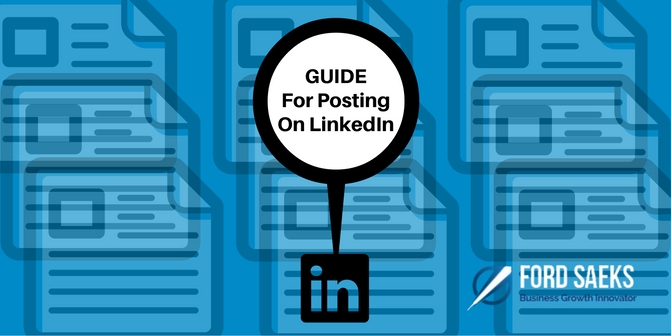Twitter and Facebook might gain you more shares, but in business LinkedIn reigns, sending almost four times more direct traffic to corporate homepages than other social sites. LinkedIn should be part of your content marketing strategy and media calendar, but avoid the trap of just posting content to post content. Make sure it’s solution-based, relevant, intriguing, and engaging for your target audience.
Keep in mind, there is a difference between posting status updates and publishing an article. Today, I’ll be focusing on article publishing. (This post assumes that you’re already familiar with how to join groups find and connect with influencers. If not, I’d suggest you leverage the basic LinkedIn training.) Now, on to the good stuff.
Here’s a quick guide to help when you aren’t sure what to post on LinkedIn.
Who Do I Target on LinkedIn?
Here are some basic considerations: When you post on LinkedIn, you can post on your personal profile or your company profile, but also on groups and sent directly to influencers. When you post on LinkedIn, you need to know who your audience is. This may seem obvious, but too often, people just ramble ideas without knowing who they’re talking to.
Your ideal target is other industry professionals. Share your posts with large groups (more than 1000,000 members) that would find the content relevant. This will increase the reach of each post. You can also send LinkedIn Influencers content because it provides them with a way to connect and they just might share your valuable content with their huge following.
What Do I Post on LinkedIn?
Start with a brain dump of at least the top 25 questions that you or your company get asked most frequently about your products or services. Remember, 6 out of every 10 LinkedIn users are interested in industry insights. Apply as many as 3 tags to your original post, which will affect if your post is profiled on a LinkedIn channel. Having a post profiled could massively increase its exposure, driving traffic to your profile and your site. Also, focus on “top” lists, which have nearly 40 percent more amplification than other types of posts. A good tip is to share others’ written content as well as images and infographics as this promotes reciprocity.
Where Do I Stop?
Keep in mind that your post is really never too long, only too boring. However, average adults read at a speed of 300 words per minute, and busy professionals won’t want to give an article more than 3 minutes of their time, so stop right around 900 words, max. To convert a one-time reader into an avid follower, add a link to a previous post and/or your profile. LinkedIn updates containing links reach 45 percent higher follower engagement than those without links.
How Do I Write a Catchy Headline?
Face it, your job is to interrupt the reader and get your content noticed. This happens by having a compelling, benefit-driven headline. Think about other sites you visit, magazines you read, and content that makes you stop what you’re doing because the title caught your attention. The headline is 90% of getting someone to read your post. There are many different styles of writing headlines, for example: using questions, how-to, news-style, testimonial, command, etc. A standard rule of thumb if you are using a list, is to make it odd numbered with less than 12 words. The most shared titles are how-tos, reasons-why, or why-I posts.
Why Should I Add an Image?
Because you want your post to be noticed. Don’t even bother posting without adding an image. That should be a standard practice with all of your social media and blog posts. We are all operating in a visual medium and visuals attract attention. 98% of LinkedIn posts with images get a higher comment rate than those without, so this one is a no-brainer.
Size matters in this equation, too. LinkedIn recommends that when you post on their site, your images should be 700 x 400 pixels. A few good web-based, free resources for creating branded images that include the ability to customize text overlays are Canva, Pablo, or PicMonkey. There are also several social media apps, so if you’re posting from your phone, you can create custom graphics, for example Wordswag.
When Do I Post?
A better question may be to ask “How committed are you to leveraging the power of LinkedIn?” Why? Because if you’re going to be effective with LinkedIn, you need to plan on posting an article each week and an update each day. That said, business hours, in general, have the largest maximum reach. LinkedIn has found that 20 posts per month can help you reach 60 percent of your unique audience. It’s worth devoting the time to, because 91% of B2B marketers are already using LinkedIn for sharing content. And only 42% of them feel like they’re doing it effectively. If you follow these tips, you’ll be in the group that knows what they’re doing is having an impact.
LinkedIn has evolved to be about more than just finding jobs or employees. It’s now a hub for all things business and industry. For connecting with like-minded professionals and for building a network that is buzzing with shareable content and useful insights. Join the club. Become a leader to improve your influence, engagement, and ultimately build relationships to capture leads and new business. Post on LinkedIn to share your expertise and generate social proof. When the information is exceptional, you’re bound to go viral. So what do you think? Let me know in the comments below and share information with me on your strategies for business growth.
 (316) 844-0235
(316) 844-0235 Contact Us
Contact Us
0 Comments